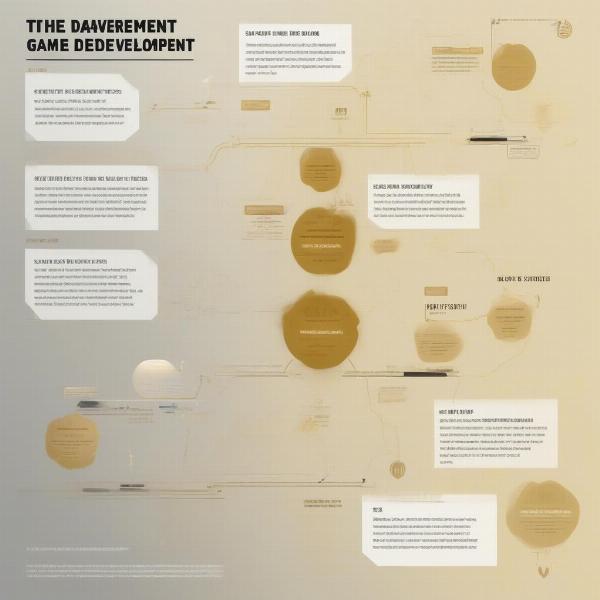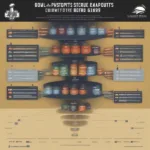When a game “goes gold,” it signifies a crucial milestone in its development lifecycle. It means the master version of the game is complete and ready for manufacturing and distribution. This doesn’t necessarily mean it’s bug-free or the final version players will experience, but it’s a major step towards release.
The Significance of “Going Gold” in Game Development
Going gold represents the culmination of years of hard work and dedication from countless developers, artists, designers, and testers. It’s the moment when the core game, as envisioned, is locked in and ready to be duplicated. Think of it as the final manuscript being sent to the printers for a book. While minor tweaks and corrections might still happen, the fundamental content is finalized. This stage is crucial for physical copies of the game, as manufacturing requires ample time, especially for large-scale releases.
Going gold is an important moment for both the development team and the eagerly awaiting fans. For the development team, it’s a moment of celebration and a sign that their project is almost ready to reach the world. For the fans, it means the game is definitely coming, and the release date is likely set in stone. It builds anticipation and reinforces the upcoming launch.
While “going gold” traditionally meant the game was ready for physical production, the digital era has somewhat altered its meaning. With digital distribution platforms like Steam, PlayStation Network, and Xbox Live, physical copies are less dominant. However, the term still holds weight, signifying the completion of the main development phase.
From Gold Master to Day One Patch: What Happens Next?
Once a game goes gold, the focus shifts from core development to polishing, refining, and preparing for launch. This often involves addressing bugs discovered during the final testing phases or incorporating feedback from early access players. These improvements are typically bundled into a “day one patch,” a downloadable update available at launch. The day one patch has become commonplace, allowing developers to continue optimizing the game even after the gold master is submitted.
Sometimes, a game might go gold several weeks or even months before its official release date. This time allows for marketing campaigns to ramp up, pre-orders to be fulfilled, and the physical distribution network to get ready. It also allows developers to concentrate on finalizing the day one patch, addressing critical issues, and optimizing performance.
Why Does the “Gold” Terminology Exist?
The term “going gold” harks back to the days when games were distributed primarily on physical media, specifically CD-ROMs. The master copy, from which all other copies were made, was etched onto a gold-plated disc for durability and error-free duplication. This gold master disc represented the final, approved version of the game. Hence, the phrase “going gold” became synonymous with achieving this crucial milestone. Although gold-plated discs are no longer commonly used, the term has stuck around, reflecting a significant moment in the game development process.
 Developers Celebrating Game Going Gold
Developers Celebrating Game Going Gold
Understanding the Nuances of “Going Gold”
It’s important to understand that “going gold” doesn’t equate to a perfect, bug-free game. While it indicates the completion of the main development phase, it’s not uncommon for games to have some remaining bugs or issues that are addressed through patches post-release. This is especially true in today’s complex game development landscape, where vast open worlds and intricate gameplay systems can make it challenging to catch every bug before launch. Going gold is a critical stage, but not the final destination in the journey of game development.
The increasing prevalence of early access and beta testing programs has also influenced the meaning of “going gold.” These programs allow developers to gather player feedback and identify potential problems before the official release. This iterative development process often continues even after the game has gone gold, leading to further refinements and improvements included in day one patches or subsequent updates. This approach allows for a more collaborative development process and ensures the final product is more polished and aligned with player expectations.
Similar to the issues discussed in why do my xbox games have a warning sign, unforeseen issues can arise even after a game goes gold.
The Future of “Going Gold” in a Digital Age
As digital distribution becomes increasingly dominant, the traditional meaning of “going gold” continues to evolve. While physical copies still exist, the focus has shifted to releasing games digitally. This allows for faster updates and patches, making the distinction between “going gold” and the final release version less clear-cut. The term itself may eventually become obsolete, replaced by new terminology that reflects the changing landscape of game development and distribution. However, for now, it still marks a significant milestone, signifying the completion of core development and the transition towards launch.
Common Questions About Games Going Gold
Is a game bug-free when it goes gold? Not necessarily. While the core game is complete, bugs can still exist and are often addressed in day one patches.
What happens after a game goes gold? The focus shifts to final testing, polishing, and preparing for launch, including the creation of a day one patch.
Why is it called “going gold”? The term originated from the use of gold-plated discs for master copies in physical game distribution.
Does “going gold” still matter in the digital age? Yes, it signifies the completion of core development, even though the final release might include further updates.
What is a day one patch? It’s a downloadable update available at launch, often containing bug fixes and improvements.
How long after going gold is a game released? This can vary, ranging from a few weeks to several months.
What does going gold mean for gamers? It confirms the game’s imminent arrival and allows for pre-orders and marketing to intensify.
 Game Release Timeline with Gold Status Highlighted
Game Release Timeline with Gold Status Highlighted
The Impact of Early Access on Going Gold
Early Access has significantly changed the landscape of game development. Games in Early Access are essentially playable works-in-progress, allowing developers to gather valuable feedback directly from players. This feedback loop can be instrumental in identifying bugs, balancing gameplay, and refining features. While the term “going gold” still signifies the completion of core development for Early Access titles, the line is often blurred as development continues alongside player engagement. This iterative development process can lead to more polished and refined games upon their full release.
Conclusion
“Going gold” signifies a crucial moment in a game’s journey, marking the completion of core development and the beginning of the final stages before release. While the term originates from a bygone era of physical media, it continues to hold relevance in the digital age. It symbolizes the culmination of hard work, dedication, and creativity, bringing a game one step closer to being enjoyed by players worldwide. While day one patches and ongoing updates have become standard practice, “going gold” remains a significant milestone in the game development lifecycle, signifying the game’s readiness for the world.

